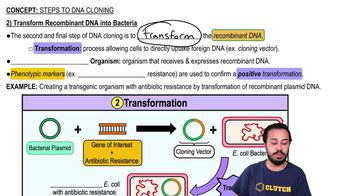Table of contents
- 1. Introduction to Biology2h 42m
- 2. Chemistry3h 40m
- 3. Water1h 26m
- 4. Biomolecules2h 23m
- 5. Cell Components2h 26m
- 6. The Membrane2h 31m
- 7. Energy and Metabolism2h 0m
- 8. Respiration2h 40m
- 9. Photosynthesis2h 49m
- 10. Cell Signaling59m
- 11. Cell Division2h 47m
- 12. Meiosis2h 0m
- 13. Mendelian Genetics4h 44m
- Introduction to Mendel's Experiments7m
- Genotype vs. Phenotype17m
- Punnett Squares13m
- Mendel's Experiments26m
- Mendel's Laws18m
- Monohybrid Crosses19m
- Test Crosses14m
- Dihybrid Crosses20m
- Punnett Square Probability26m
- Incomplete Dominance vs. Codominance20m
- Epistasis7m
- Non-Mendelian Genetics12m
- Pedigrees6m
- Autosomal Inheritance21m
- Sex-Linked Inheritance43m
- X-Inactivation9m
- 14. DNA Synthesis2h 27m
- 15. Gene Expression3h 20m
- 16. Regulation of Expression3h 31m
- Introduction to Regulation of Gene Expression13m
- Prokaryotic Gene Regulation via Operons27m
- The Lac Operon21m
- Glucose's Impact on Lac Operon25m
- The Trp Operon20m
- Review of the Lac Operon & Trp Operon11m
- Introduction to Eukaryotic Gene Regulation9m
- Eukaryotic Chromatin Modifications16m
- Eukaryotic Transcriptional Control22m
- Eukaryotic Post-Transcriptional Regulation28m
- Eukaryotic Post-Translational Regulation13m
- 17. Viruses37m
- 18. Biotechnology2h 58m
- 19. Genomics17m
- 20. Development1h 5m
- 21. Evolution3h 1m
- 22. Evolution of Populations3h 52m
- 23. Speciation1h 37m
- 24. History of Life on Earth2h 6m
- 25. Phylogeny2h 31m
- 26. Prokaryotes4h 59m
- 27. Protists1h 12m
- 28. Plants1h 22m
- 29. Fungi36m
- 30. Overview of Animals34m
- 31. Invertebrates1h 2m
- 32. Vertebrates50m
- 33. Plant Anatomy1h 3m
- 34. Vascular Plant Transport1h 2m
- 35. Soil37m
- 36. Plant Reproduction47m
- 37. Plant Sensation and Response1h 9m
- 38. Animal Form and Function1h 19m
- 39. Digestive System1h 10m
- 40. Circulatory System1h 57m
- 41. Immune System1h 12m
- 42. Osmoregulation and Excretion50m
- 43. Endocrine System1h 4m
- 44. Animal Reproduction1h 2m
- 45. Nervous System1h 55m
- 46. Sensory Systems46m
- 47. Muscle Systems23m
- 48. Ecology3h 11m
- Introduction to Ecology20m
- Biogeography14m
- Earth's Climate Patterns50m
- Introduction to Terrestrial Biomes10m
- Terrestrial Biomes: Near Equator13m
- Terrestrial Biomes: Temperate Regions10m
- Terrestrial Biomes: Northern Regions15m
- Introduction to Aquatic Biomes27m
- Freshwater Aquatic Biomes14m
- Marine Aquatic Biomes13m
- 49. Animal Behavior28m
- 50. Population Ecology3h 41m
- Introduction to Population Ecology28m
- Population Sampling Methods23m
- Life History12m
- Population Demography17m
- Factors Limiting Population Growth14m
- Introduction to Population Growth Models22m
- Linear Population Growth6m
- Exponential Population Growth29m
- Logistic Population Growth32m
- r/K Selection10m
- The Human Population22m
- 51. Community Ecology2h 46m
- Introduction to Community Ecology2m
- Introduction to Community Interactions9m
- Community Interactions: Competition (-/-)38m
- Community Interactions: Exploitation (+/-)23m
- Community Interactions: Mutualism (+/+) & Commensalism (+/0)9m
- Community Structure35m
- Community Dynamics26m
- Geographic Impact on Communities21m
- 52. Ecosystems2h 36m
- 53. Conservation Biology24m
7. Energy and Metabolism
Enzymes
Problem 5`
Textbook Question
Some bacteria are metabolically active in hot springs because
a. They are able to maintain a lower internal temperature.
b. High temperatures make catalysis unnecessary.
c. Their enzymes have high optimal temperatures.
d. Their enzymes are completely insensitive to temperature.
 Verified step by step guidance
Verified step by step guidance1
Understand that enzymes are proteins that catalyze biochemical reactions and are sensitive to temperature changes.
Recognize that each enzyme has an optimal temperature range where it functions most efficiently. This is crucial for bacteria living in extreme environments like hot springs.
Consider that bacteria in hot springs must have enzymes adapted to high temperatures, allowing them to remain metabolically active despite the heat.
Evaluate the options given: a) maintaining a lower internal temperature is unlikely due to the surrounding environment, b) catalysis is necessary for metabolic processes, c) enzymes with high optimal temperatures would be beneficial, d) complete insensitivity to temperature is improbable.
Conclude that the most plausible explanation is that these bacteria have enzymes with high optimal temperatures, allowing them to thrive in hot springs.
 Verified video answer for a similar problem:
Verified video answer for a similar problem:This video solution was recommended by our tutors as helpful for the problem above
Video duration:
1mPlay a video:
Was this helpful?
Key Concepts
Here are the essential concepts you must grasp in order to answer the question correctly.
Enzyme Optimal Temperature
Enzymes are proteins that catalyze biochemical reactions, and each enzyme has an optimal temperature at which it functions most efficiently. In thermophilic bacteria, enzymes are adapted to high temperatures, allowing them to remain active and stable in hot environments like hot springs. This adaptation is crucial for the survival and metabolic activity of these bacteria.
Recommended video:
Guided course

Enzymes Example 1
Thermophilic Bacteria
Thermophilic bacteria are microorganisms that thrive at relatively high temperatures, typically between 45°C and 80°C. These bacteria have evolved to survive and grow in extreme heat, such as that found in hot springs, by developing specialized proteins and enzymes that remain stable and functional at elevated temperatures.
Recommended video:
Guided course

2) Transform Recombinant DNA into Bacteria
Enzyme Sensitivity to Temperature
Enzymes are sensitive to temperature changes, which can affect their structure and function. While most enzymes denature at high temperatures, thermophilic bacteria possess enzymes that are less sensitive to heat, allowing them to maintain their catalytic activity in hot environments. This insensitivity is a key adaptation for life in extreme thermal conditions.
Recommended video:
Guided course

Enzymes Example 1
Related Videos
Related Practice
















